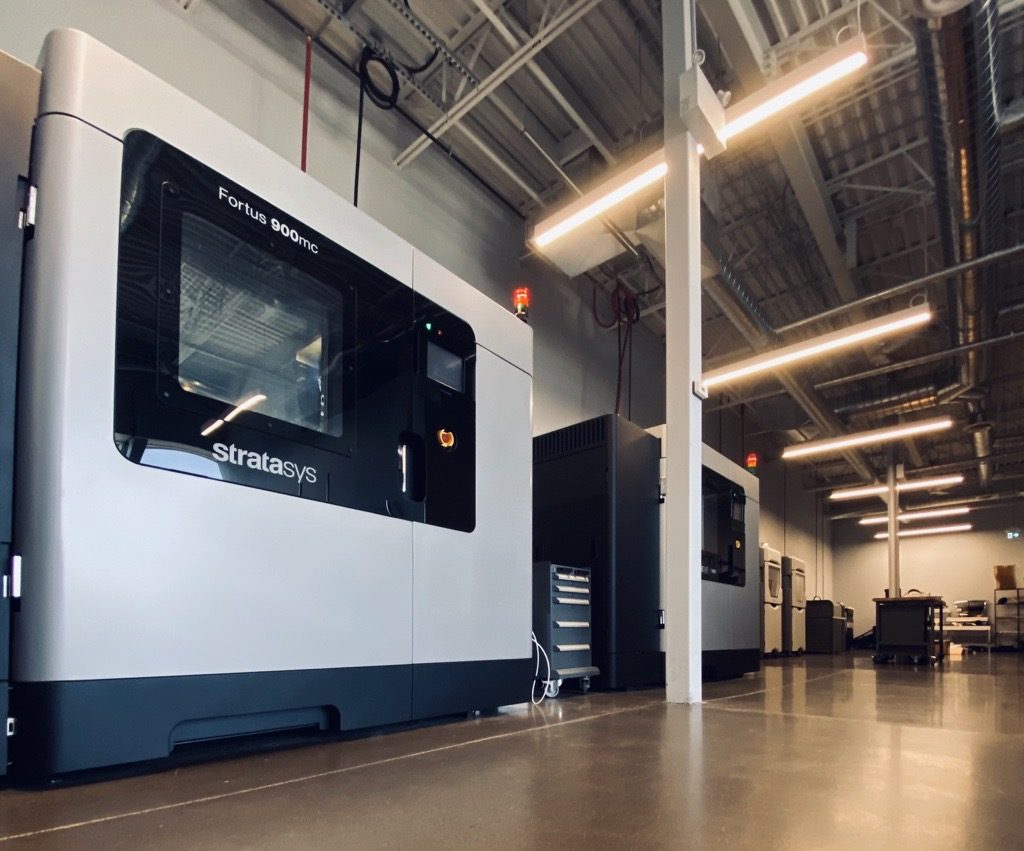
Learning 4.0: Additive manufacturing continues toward higher-volume production
October 12, 2021
By Maxime Lacouture
 Photo: Javelin
Photo: Javelin From a single 3D printer in a classroom or design studio to rows of production machines on a factory floor, additive manufacturing continues its rapid evolution, becoming an increasingly important tool in the manufacturing mix.
Previous barriers to widespread adoption – including cost, speed, size, volume and material choice – are falling quickly. Industrial 3D printing is no longer niche or nice-to-have. It’s a viable method of production.
Preparing for the future
To improve access to the latest technology, and to keep building a future full of additive manufacturing specialists, students, faculty, and small businesses have access to Javelin – A TriMech Company through on-campus research and innovation centres across Canada, including at the Barrett Centre for Technology Innovation (CTI) at Humber College in Toronto.
The Barrett CTI is home to Humber’s Advanced Manufacturing Skills Consortium, a group of nine industry partners. Javelin is the lead partner for additive manufacturing and supports the Centre’s two Stratasys Fortus 450mc 3D printers, along with various other printers across the campus.
In the Barrett CTI, access to real-world additive manufacturing equipment, combined with the other Industry 4.0 technologies available on site, promotes rich learning in STEM fields, equips our future workforce and supports the start-up and small business community. Students and industry can turn their designs into reality, using technology they wouldn’t otherwise be able to access.
Variety of materials
The 450mc is ideal in both educational and industrial environments for advanced prototypes, jigs and fixtures, and end-use parts that require engineered thermoplastics.
Material examples include the tough FDM Nylon 12 (with chopped carbon fibre), which can replace metal in some applications; the chemical-resistant Antero 800NA; and Ultem 1010, which withstands temperatures as high as 421°F (216°C).
No special facility requirements are needed, offering the flexibility to install Fortus printing systems anywhere. Operators also learn and work fast.
At the Barrett CTI, even with public health restrictions, the two printers have been valuable. At the outset of the pandemic, staff used additive technology to produce protective face shields to support the local healthcare community. Post-secondary students completing industry capstone projects can access the printers, and the Barrett CTI supports a STEM outreach team that inspires thousands of local middle school and high school students.
The Stratasys Fortus 450mc also prints components for Humber’s automated guided vehicle (AGV). The Humber Hawk is built by third-year electromechanical technology students under the leadership of the Barrett CTI director and with partner support.
Increasing productivity
The Stratasys F-series family continues to grow to meet the needs of engineers and manufacturers. The new F770 makes large-format FDM 3D printing more accessible and economical. With a build chamber sized 39” x 24” x 24”, you can print one or several large parts or make many small parts to increase productivity.
It builds accurate parts from batch to batch, overcoming repeatability challenges seen with previous large-format systems.
The advanced technology driving the new Stratasys Origin One (Programmable Photopolymerization or P3) and the Stratasys H Series Production Platform (Selective Absorption Fusion) controls the print process to allow production of tens of thousands of end-use parts from a variety of high-performance materials for high heat, high impact, or medical certification. Components meet the quality standards of injection-moulded parts.
Printing in metal is gaining popularity, even in small shops. Office-friendly ExOne 3D printers quickly create metal, ceramic, and composite production parts with excellent dimensional tolerances. The Xact Metal XM200C makes metal powder-bed fusion 3D printing affordable for educational institutions, labs and small-to-medium businesses that need prototyping and tooling.
Overall, as the pace of change keeps accelerating, advances in medium- to high-volume production are happening fast.Manufacturers in all sectors will continue to find new ways to advance their design process and digital workflows, improve time-to-market, and make complex, custom parts in larger numbers. Exploring additive manufacturing in a post-secondary environment is a good way to test technology before bringing it to scale.
Maxime Lacouture has 15 years of manufacturing industry experience and is a national sales manager at Javelin Technologies – A TriMech Company. Javelin is a provider of additive manufacturing and SOLIDWORKS 3D CAD software solutions. maxime.lacouture@javelin-tech.com.
This article is part of a series giving manufacturers a look behind the walls of the Barrett Centre for Technology Innovation. For more information on the Centre, please contact askbarrettcti@humber.ca.
This article appears in the September 2021 issue of Manufacturing AUTOMATION.
Advertisement
- NGen’s latest tech report discusses Canada’s artificial intelligence landscape
- Western Manufacturing Technology Show live and in-person